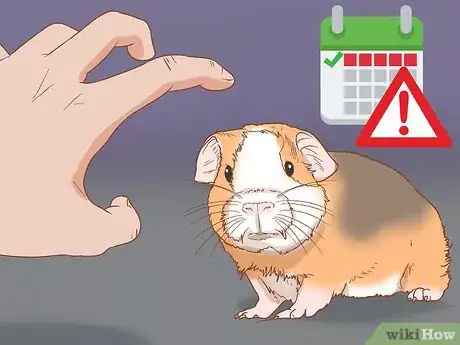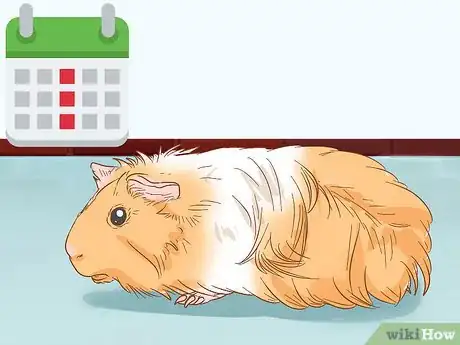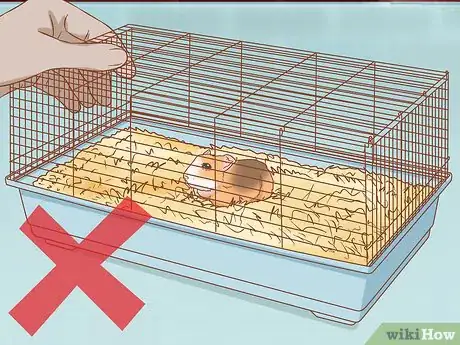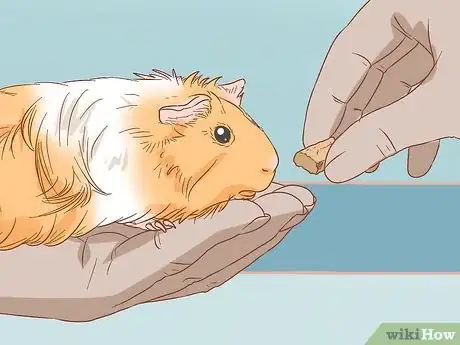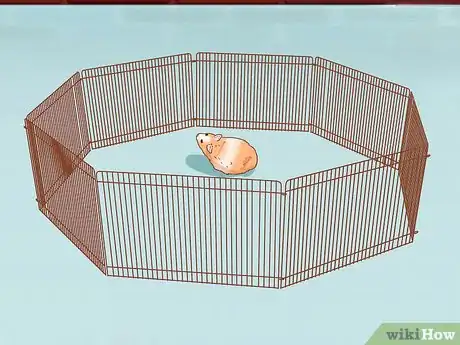This article was co-authored by Pippa Elliott, MRCVS. Dr. Elliott, BVMS, MRCVS is a veterinarian with over 30 years of experience in veterinary surgery and companion animal practice. She graduated from the University of Glasgow in 1987 with a degree in veterinary medicine and surgery. She has worked at the same animal clinic in her hometown for over 20 years.
This article has been viewed 58,446 times.
Guinea pigs are social creatures, and being separated from their littermates is a stressful process. They can also be pretty jumpy by nature, and depending on the temperament of your pig, it can potentially take months for them to adapt to you. Luckily, there are some tips to make the process as easy as possible for your pig to help it get comfortable with its new home and new owner!
Steps
Starting a Healthy Routine
-
1Avoid handling your guinea pig for the first few days. When you first get your guinea pig, you'll probably be excited and want to handle it right away. But to help it adjust, it's important to avoid this—handling too early will stress it out. For the first few days, avoid handling unless it's necessary. Talk to it softly and give it time to get used to you.[1]
- When you have to handle your guinea pig, put your hand close to it first to let it smell you. Remember that guinea pigs have poor vision.
- Always handle your guinea pig by grasping its shoulders while using your free hand to support its backside. When you lift it, keep one hand underneath it for support and the other on its shoulders to keep it from jumping.
-
2Feed your guinea pig a nutritious and varied diet. Guinea pigs have approximately 17,000 taste buds, which tops almost any wild or domestic animal. This means they appreciate a good diet! Always feed your guinea the right diet and change things up whenever you can. It should always have access to high-quality grass hay, 1/4 to 1/8 cup (7.09 to 3.54 grams) of guinea pig pellets daily, and 1 cup (182 grams) of vegetables at most.[2]
- Make sure your guinea pig gets 10 to 30 milligrams (0.000353 to 0.001058 ounces) of vitamin C daily.
- Switch your vegetables up with zucchini, raspberry leaves, radicchio, grapes, raspberries, bananas, cucumbers, and squash.
- Always introduce new foods slowly. Let it try them out and take note of what they like—the effort will pay off!
Advertisement -
3Give your guinea pig floor time at least once a week. Just like dogs need walks, guinea pigs need floor time. Choose a time every week (or more when they're comfortable) and stick to it. Select a location that's safe and big enough that it can run around, with enough nooks and crannies it can hide in. Scatter some food and put them in hiding places. Use this time to play and bond with your guinea pig. For example, sit next to it as it explores and plays.
- Speak softly or sing to your guinea pig during floor time.
- Set up obstacles and mazes with fabrics and boxes.
- Take floor time to get to know your guinea pig's personality. If it's jumpy, don't get too close until it's comfortable. You'll know it's comfortable with you when it comes back to check on you periodically as it explores.
- Purchase Hideys from pet stores if you need to create hiding places.
-
4Stick to a consistent schedule. Guinea pigs do better when they can keep the same habits. This means giving treats, conducting weight-checks, and floor time should happen at the same time as often as possible. Try to pick a specific time for every activity and stick to it—your guinea pig will feel more safe and secure.
- A consistent routine is most important with new environments and activities. For example, taking your guinea pig out of its cage and holding it at the same time each day will make these activities less stressful.
-
5Don't touch your guinea pig's cage unless necessary. Unless it's in grave danger, don't take your guinea pig out of hiding and keep your hands off of its cage. Avoid chasing, grabbing, or cornering it. To get it out of its cage, use a piece of parsley to tempt it and get it to climb out. After it eats the parsley, it might warm up to you enough to let you hold it.[3]
- If you have to reach into its cage put your hand about 1 foot (12 in) away from it.
- The only time you should grab your guinea pig from a hiding place is in an emergency, such as a fire, or when it has eaten something poisonous.
- Even if you're just planning on doing something quietly in the room, follow the above steps to let your guinea pig know who's in the room with them—this will make them much less anxious.
-
6Keep noise around your guinea pig low. When you talk to your pig or when you're near it, keep your voice low—a conversational volume is best. Guinea pigs have great hearing, which means high volumes can exacerbate with their anxious temperament. If you have loud friends over, keep them out of the guinea pig area.[4]
- Avoid loud and sudden noises around your guinea pig—even just one can make your guinea pig uncomfortable for hours.
Bonding with Your Guinea Pig
-
1Talk to your guinea pig every day. Guinea pigs don't have great sight, which can make it scary for them when someone barges into their space and reaches into their cage. However, they have a strong sense of hearing and smell, so take advantage of these senses to make them comfortable! Talk to your pig quietly as you enter the room and anytime you approach its cage.[5]
- Make an effort to talk to your guinea pig every day to get it used to your voice.
-
2Stick your hand in front of your guinea pig's nose to let it smell it. Before handling your guinea pig, let it get used to your scent. Place your hand in its cage and keep still. Let it approach it or even just get a whiff. Once it knows your voice and smell, it will get more comfortable with you.[6]
- Keep letting your guinea pig smell your hand daily.
- Don't make sudden movements with your hand while it's in the cage or you might scare your guinea pig.
-
3Hold your guinea pig in your chest or lap when it's comfortable. Start by talking to your guinea pig and letting it smell you. Afterward, trying sliding your hand under its stomach and cupping it gently. If it's comfortable with this position, continue to cup its behind and lift it off the ground. Turn it and hold it to your chest, making sure to support its back and bottom. From here, you can let it sit in your lap or keep it on your chest if it's still too jumpy.[7]
- If your guinea pig runs away when you try to pick it up, continue letting it smell your hand daily until it's comfortable enough to be handled.
- Gently pet your pig. If it's still jumpy, put your finger in front of its nose so it can smell you.
- Always talk to your guinea pig softly when you handle it.
- If you're having trouble picking up your guinea pig and keeping it still, give it a treat and put it back in its cage. Don't rush it or you might scare it and make future handling difficult.
-
4Give your guinea pig treats during and after handing it. When you have to handle your guinea pig, give it some treats while holding it as well as afterward to calm it down. This will reward it and make it less anxious about getting handled.[8]
- Great treats include botanical hay, oat hay, orchard grass hay, clover and alfalfa hays, timothy hay, and grass hays.
- Guinea pig pellets are great treats that possess nutrients not found in hays, such as phosphorous, biotin, and various vitamins.
Letting Your Guinea Pig Explore and Socialize
-
1Start socializing your guinea pig in familiar areas. When you start getting to know your pig, it's best to do so when it's comfortable and in familiar locations associated with positive memories. For example, if you want to hold your guinea pig, do so in a room it's familiar with, such as the cage room or the room it's allowed to roam in.[9]
- Remember that every stressful interaction with your guinea pig makes it less likely they will want to spend time with you.
- Create as many positive associations with your guinea pig as possible.
-
2Place your guinea pig in new areas when it's more comfortable. As your guinea pig becomes more accustomed to you, you should start exposing it to new situations. Take it slow: introduce it to new areas or rooms, but keep some areas fenced off. Gradually remove the fences over time as it gets comfortable. If you have a guinea pig that's on the confident side, you can skip the fences.[10]
- Take your time and don't stress your guinea pig out.
- Move slowly, but always try! The more you get your guinea pig accustomed to new areas, the happier it will be with new places and people in the future and the better your relationship will be.
-
3Consider getting another guinea pig. Since guinea pigs are social animals, the friendship of another guinea pig will help it ease into their home and become more comfortable around you. Luckily, it's almost no additional cost to get another guinea pig. Just make sure it's the opposite sex, and try to match a dominant pig with a subordinate pig.[11]
- If you don't have enough time to determine the new pig's personality, pair old with young. For example, if your current guinea pig is old, get a young pig, and vice versa.
- Remember that there's always a chance your new guinea pig won't get along with your old one. Weigh the pros and cons, the available alternatives, and ask yourself if it's worth the risk!
Warnings
- Never mix an uncastrated male with a female guinea pig unless you want lots more!⧼thumbs_response⧽
- Be careful when handling—guinea pigs can be very fragile, and if you squeeze them too hard or step on them they can get severely hurt.⧼thumbs_response⧽
- Keep pets such as cats, dogs, and rabbits away from your guinea pigs. You should also keep them away from young children.⧼thumbs_response⧽
References
- ↑ https://www.petful.com/other-pets/make-guinea-pig-love/
- ↑ http://www.happycavy.com/what-can-guinea-pigs-eat/
- ↑ http://www.happycavy.com/how-to-build-stronger-bond-with-guinea-pig/
- ↑ http://www.happycavy.com/how-to-build-stronger-bond-with-guinea-pig/
- ↑ http://www.happycavy.com/how-to-build-stronger-bond-with-guinea-pig/
- ↑ http://www.happycavy.com/how-to-build-stronger-bond-with-guinea-pig/
- ↑ http://www.happycavy.com/how-to-build-stronger-bond-with-guinea-pig/
- ↑ http://www.happycavy.com/how-to-build-stronger-bond-with-guinea-pig/
- ↑ http://www.guineapigtricks.com/taming--bonding.html
About This Article
To help your guinea pig adjust to you, talk to it every day so it gets used to your voice. Also, before you try to handle your guinea pig, let it smell your hands for a few days so it's familiar with your smell. Then, once it seems less afraid of you, hold it in your lap and give it treats to calm it down. Just avoid chasing, grabbing, or cornering your guinea pig since it will make it more afraid of you. Instead, be patient and wait for your guinea pig to adjust to you on its own time. For more tips from our Veterinary co-author, like how to socialize your guinea pig, read on!
